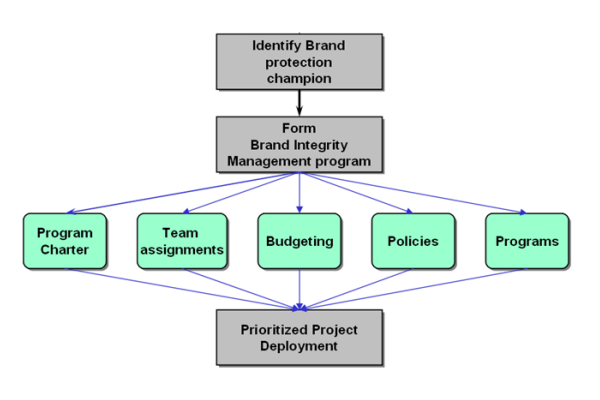Elements of Brand Integrity Management

Taking a comprehensive approach is necessary to design and develop a successful Brand Integrity program that will effect change in the organization. The figure at right outlines elements of a proactive approach to establishing a Brand Integrity Management program.
Brand Protection Champion
One of the real challenges facing any company looking to establish a focus on Brand Integrity is the lack of a single owner or department within the Company whose charter is to ensure the customer experience meets the brand ideals. The brand protection champion(s) should be one or more individuals who are given the authority and corporate commitment to effect change.
Brand Integrity Management Program
As the span of control is too great for a single organizational entity, many companies will benefit from forming ongoing councils and programs chartered with establishing patient safety and product integrity. Five key elements make up a strong program:
1. Establish a program charter
Clearly setting goals, objectives and scope of involvement will help define the Total Brand Integrity Management program, allowing management to understand the reasons for the program as well as the resource requirements. The charter should contain:
- Problem statement and definition of intended outcomes
- Which Brands and products are included
- Scope of involvement by business function from a product lifecycle perspective
- Identification of unacceptable behaviors from a customer experience perspective
- Anticipated timing of key deliverables
- Key benefits to the business
- Desired leader, team members and their roles and responsibilities
2. Form a cross-enterprise governing council
Given organizational inertia and potentially conflicting priorities, establishing Brand Integrity initiatives will require committed leadership and cross functional strategic alignment. Enlist a team of representatives from various functions likely to be impacted by Brand Integrity initiatives. These organizations would likely include:
- Product design
- Product packaging
- Supply chain
- Information systems
- Channel sales
- Marketing
- Security
- Legal
- Regulatory compliance
- Distribution channel
- Customer service
3. Program budgeting and funding
Establishing a budget and funding of key deliverables will enable the Team to identify areas of change and to invest in activities which will significantly enhance Brand Integrity. In order to secure such funding, an understanding of susceptibilities, their risk to the Brand and the associated business case needs to be developed.
4. Policies
Following an understanding of susceptibilities and potential impact to the integrity of the Brand, members of the Brand Integrity Management Team should establish clearly defined and communicated policies. Defining the standards of acceptable behaviors from a brand experience perspective is important to meeting Brand Integrity goals. Examples of policies might include:
- We will protect our patients, our company, and our brand by providing product security solutions and features on all of our products.
- All products at risk are to have multiple layers of authentication security incorporated into the product design.
- Non-experts should be able to authenticate our product without relying on specialized equipment for authentication.
- All inquiries and product concerns regardless of perceived significance are to be logged into a centralized event logging repository for Brand managers and investigators to review and launch investigations.
- We will have zero tolerance for any employee, distributor or customer actions which put the Brand at risk of vulnerability.
5. Programs
Based on assessing gaps in the current and desired state of product protection and integrity, the Brand Integrity Management Team should establish prioritized projects having significant impact on improving the customer experience or minimizing the risk of susceptibility to identified threats. Project planning should incorporate goals, objectives, deliverables, timing and metrics of success. Some companies will seize on a single significant initiative such as establishing and tracking unique product identifiers for every level of packaging, while other companies will establish a series of smaller, focused initiatives impacting their Brands or market segments most at risk. Some questions the Brand Integrity Management Team should consider are:
- What are the greatest susceptibilities of the Brand?
- Why is addressing these susceptibilities important?
- What is the proposed process change, system improvement, package redesign, and/or security feature(s)?
- Why is it worth implementing?
- How secure is it?
- What products and/or product-packages are impacted?
- How will the product and/or product-packages be changed?
- What changes are necessary to implement, who will be responsible for making changes and where will they occur?
- Who will test and certify the product? How?
IN SUMMARY
Attaining Brand Integrity means making sure the customer experience lives up to expectations. Pharmaceutical customers above all else expect their products to be safe and effective. The Leading pharmaceutical companies will find ways to make sure the customer experience meets or exceeds customer expectations.
Threats that negatively impact the customer experience need to be managed. Some aspects of the customer experience can proactively be controlled and can be dictated by factors such as market communications, product and product package design. Other aspects can be influenced but not fully controlled. Counterfeiting and tampering, for instance, cannot be stopped; however the risk to the Brand can be greatly minimized by having appropriate management attention, processes, and systems in place. As a result, compromised product can be quickly identified and removed from the market, and actions accelerated to minimize the impact to patients and customers. Preventing the distribution of contraband will minimize the profit potential for brand pirates and eventually force them to seek other, easier to infiltrate products.
At the heart of Total Brand Integrity is the recognition that susceptibility arises from vulnerability in one or more of the following areas: integrity management and enforcement, pricing/promotion, product design, supply chain, distribution channel, or regulatory compliance. A Total Brand Integrity focus brings a more proactive approach to every aspect of the customer experience.
Focusing on Brand Integrity keeps patients and customers safe and secure and builds their trust and loyalty. Getting a Brand on the path of high integrity will maintain its promise and yield long term success and sustainability.



